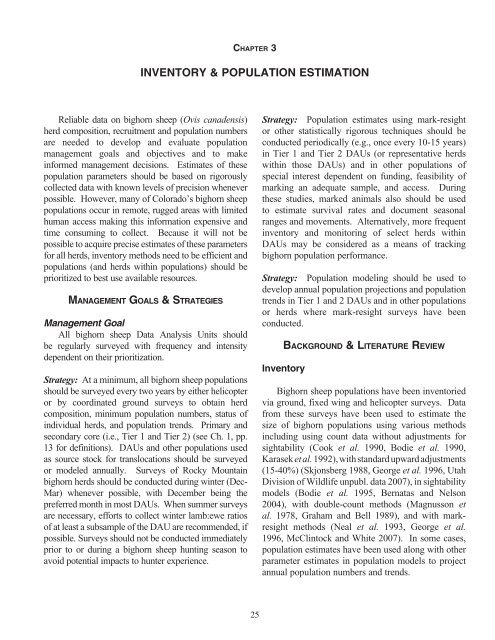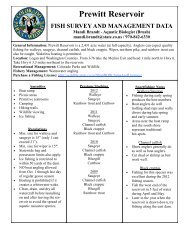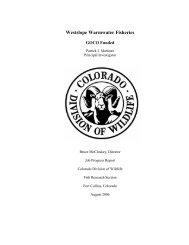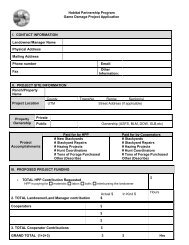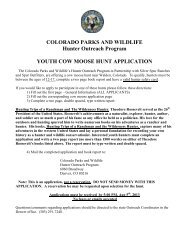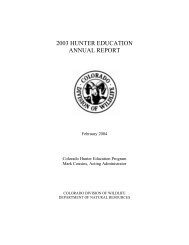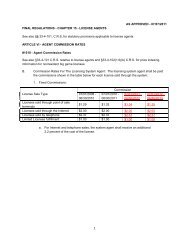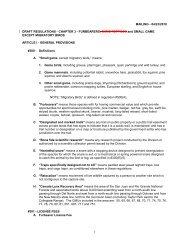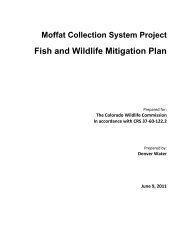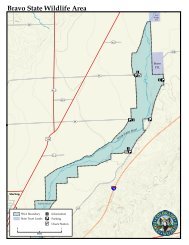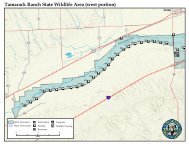COLORADO BIGHORN SHEEP MANAGEMENT PLAN 2009−2019
COLORADO BIGHORN SHEEP MANAGEMENT PLAN 2009−2019
COLORADO BIGHORN SHEEP MANAGEMENT PLAN 2009−2019
You also want an ePaper? Increase the reach of your titles
YUMPU automatically turns print PDFs into web optimized ePapers that Google loves.
Chapter 3<br />
INVENTORY & POPULATION ESTIMATION<br />
Reliable data on bighorn sheep (Ovis canadensis)<br />
herd composition, recruitment and population numbers<br />
are needed to develop and evaluate population<br />
management goals and objectives and to make<br />
informed management decisions. Estimates of these<br />
population parameters should be based on rigorously<br />
collected data with known levels of precision whenever<br />
possible. However, many of Colorado’s bighorn sheep<br />
populations occur in remote, rugged areas with limited<br />
human access making this information expensive and<br />
time consuming to collect. Because it will not be<br />
possible to acquire precise estimates of these parameters<br />
for all herds, inventory methods need to be efficient and<br />
populations (and herds within populations) should be<br />
prioritized to best use available resources.<br />
ManageMent goals & strategies<br />
Management Goal<br />
All bighorn sheep Data Analysis Units should<br />
be regularly surveyed with frequency and intensity<br />
dependent on their prioritization.<br />
Strategy: At a minimum, all bighorn sheep populations<br />
should be surveyed every two years by either helicopter<br />
or by coordinated ground surveys to obtain herd<br />
composition, minimum population numbers, status of<br />
individual herds, and population trends. Primary and<br />
secondary core (i.e., Tier 1 and Tier 2) (see Ch. 1, pp.<br />
13 for definitions). DAUs and other populations used<br />
as source stock for translocations should be surveyed<br />
or modeled annually. Surveys of Rocky Mountain<br />
bighorn herds should be conducted during winter (Dec-<br />
Mar) whenever possible, with December being the<br />
preferred month in most DAUs. When summer surveys<br />
are necessary, efforts to collect winter lamb:ewe ratios<br />
of at least a subsample of the DAU are recommended, if<br />
possible. Surveys should not be conducted immediately<br />
prior to or during a bighorn sheep hunting season to<br />
avoid potential impacts to hunter experience.<br />
25<br />
Strategy: Population estimates using mark-resight<br />
or other statistically rigorous techniques should be<br />
conducted periodically (e.g., once every 10-15 years)<br />
in Tier 1 and Tier 2 DAUs (or representative herds<br />
within those DAUs) and in other populations of<br />
special interest dependent on funding, feasibility of<br />
marking an adequate sample, and access. During<br />
these studies, marked animals also should be used<br />
to estimate survival rates and document seasonal<br />
ranges and movements. Alternatively, more frequent<br />
inventory and monitoring of select herds within<br />
DAUs may be considered as a means of tracking<br />
bighorn population performance.<br />
Strategy: Population modeling should be used to<br />
develop annual population projections and population<br />
trends in Tier 1 and 2 DAUs and in other populations<br />
or herds where mark-resight surveys have been<br />
conducted.<br />
BaCkground & literature review<br />
Inventory<br />
Bighorn sheep populations have been inventoried<br />
via ground, fixed wing and helicopter surveys. Data<br />
from these surveys have been used to estimate the<br />
size of bighorn populations using various methods<br />
including using count data without adjustments for<br />
sightability (Cook et al. 1990, Bodie et al. 1990,<br />
Karasek et al. 1992), with standard upward adjustments<br />
(15-40%) (Skjonsberg 1988, George et al. 1996, Utah<br />
Division of Wildlife unpubl. data 2007), in sightability<br />
models (Bodie et al. 1995, Bernatas and Nelson<br />
2004), with double-count methods (Magnusson et<br />
al. 1978, Graham and Bell 1989), and with markresight<br />
methods (Neal et al. 1993, George et al.<br />
1996, McClintock and White 2007). In some cases,<br />
population estimates have been used along with other<br />
parameter estimates in population models to project<br />
annual population numbers and trends.


